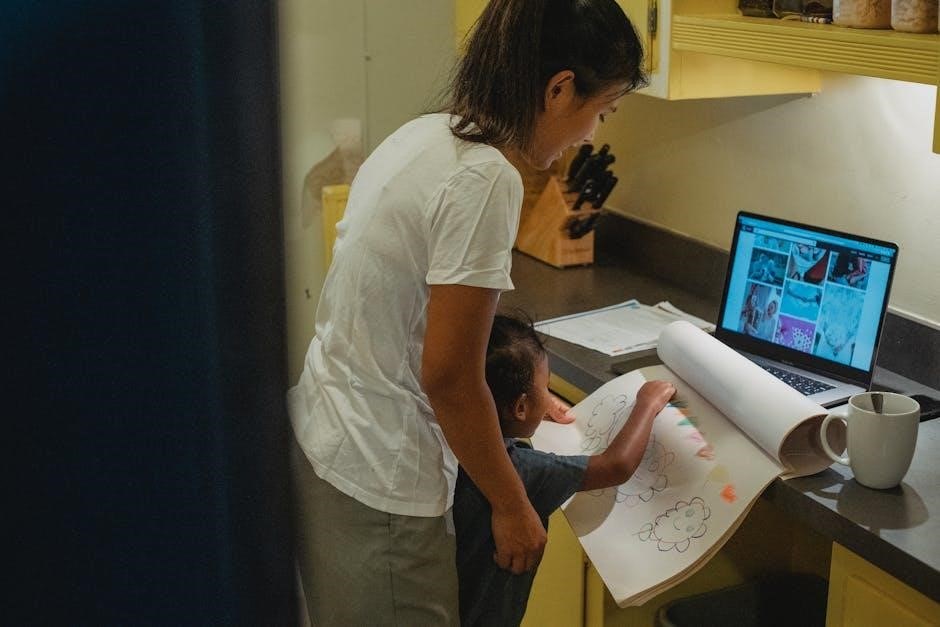a monks guide to happiness
In “A Monk’s Guide to Happiness,” Gelong Thubten offers a transformative guide to finding inner peace and joy through mindfulness and meditation, sharing practical techniques and insights.
Overview of the Book and Its Author
Gelong Thubten, a Buddhist monk with over 25 years of meditation experience, shares his wisdom in A Monk’s Guide to Happiness. Once a successful actor facing burnout, Thubten found true fulfillment in monkhood. His book offers practical, timeless techniques for cultivating inner peace and happiness through mindfulness and meditation, tailored for modern life. Thubten’s insights, gained from intensive retreats and teaching globally, provide a compassionate and accessible path to transforming one’s life and mindset.
The Central Theme: Happiness as an Inner State
A Monk’s Guide to Happiness explores the idea that true happiness is an inner state, not something found in external achievements or possessions. Thubten argues that happiness is a choice, shaped by how we respond to life’s experiences rather than the experiences themselves. By cultivating mindfulness and meditation, individuals can reconnect with their true essence and embrace a profound sense of fulfillment. The book challenges the belief that happiness is elusive, offering practical steps to nurture inner peace and joy in everyday life.
Understanding the Nature of Happiness
Gelong Thubten reveals that happiness is an inner state, rooted in how we perceive life, not in external circumstances. The book clarifies this profound concept effectively.
Why We Look for Happiness in the Wrong Places
Modern society often misleads us into seeking happiness through external sources like material wealth, status, or perfection. Gelong Thubten explains that this external focus stems from societal pressures and the illusion that fulfillment comes from achievements or possessions. However, true happiness, as the book reveals, is an internal state that arises from mindfulness, self-awareness, and inner transformation. By addressing these misconceptions, Thubten guides readers to shift their focus inward, where lasting joy and peace can be cultivated.
The Role of Mindfulness in Achieving True Happiness
Mindfulness is a powerful tool for cultivating true happiness by training the mind to focus on the present moment. It helps break the cycle of chasing external fulfillment and instead fosters inner peace. Through mindfulness, individuals can rewire their thoughts, embrace life’s impermanence, and develop emotional resilience. Regular practice allows us to observe emotions without attachment, leading to greater clarity and compassion. This mindful approach, as taught by Gelong Thubten, directly paves the path to lasting joy and contentment in everyday life.

The Monk’s Journey to Happiness
Gelong Thubten’s journey from burnout to monkhood illustrates his profound transformation, offering insights into achieving lasting inner peace through mindfulness and meditation, as detailed in his teachings.
Gelong Thubten’s Personal Story of Transformation
Gelong Thubten’s journey began with a life of fast-paced success, but at 21, severe burnout and a life-threatening heart condition led him to a Buddhist monastery. He embraced monastic life, undergoing intensive meditation retreats and studying under Tibetan masters. His transformation from misery to inner peace inspired him to teach globally, helping people from all walks of life. His story highlights resilience and the power of mindfulness, offering hope for those seeking lasting change and fulfillment.
From Burnout to Monkhood: A Path to Inner Peace
Gelong Thubten’s life shifted dramatically after suffering severe burnout and a life-threatening heart condition at 21. This crisis led him to a Buddhist monastery, where he embarked on a transformative journey. Over 25 years, he immersed himself in meditation and monastic life, overcoming personal struggles and discovering inner peace. His path from turmoil to tranquility exemplifies resilience and the profound impact of mindfulness, inspiring others to embrace change and seek fulfillment within.

Practical Steps to Cultivate Happiness
Gelong Thubten offers simple, effective exercises for busy lives, emphasizing meditation and mindfulness as foundational practices to achieve lasting happiness and inner peace.
Meditation as the Foundation of Happiness
Meditation is the cornerstone of lasting happiness, according to Gelong Thubten. By focusing on the breath and calming the mind, meditation helps cultivate inner peace and clarity. Thubten emphasizes that meditation isn’t just for stress reduction but a direct path to long-term well-being. He encourages starting with simple, short practices, even in a busy schedule, to build consistency. Over time, meditation transforms the mind, fostering resilience and joy. It’s a powerful tool to reconnect with our true selves and find fulfillment in everyday life.
Simple yet Effective Exercises for Busy Lives
Gelong Thubten offers practical, time-efficient exercises for modern lives. He suggests incorporating short meditation sessions and mindfulness into daily routines, such as focusing on the breath during commutes or breaks. These exercises help reduce stress and increase calm. Thubten emphasizes that even a few minutes of mindfulness can have a profound impact, making it accessible for everyone, regardless of how busy they are. His approach proves that happiness and peace are achievable in the midst of a hectic world.

The Power of Compassion and Kindness
Compassion and kindness are essential qualities that foster lasting fulfillment. By cultivating empathy for ourselves and others, we create a foundation for genuine happiness and connection.
Cultivating Empathy for Ourselves and Others
Cultivating empathy is a powerful practice that deepens our connection to ourselves and others. By embracing kindness and understanding, we create a bridge between self and others, fostering compassion. Gelong Thubten teaches that empathy is not just a feeling but a skill that can be developed through mindful awareness and meditation. This practice helps break down barriers, allowing us to see the shared humanity in everyone. Empathy becomes a foundation for inner peace and a way to navigate life’s challenges with grace and understanding;
How Kindness Leads to Lasting Fulfillment
Kindness is a powerful practice that fosters meaningful connections and inner peace. Gelong Thubten teaches that by cultivating compassion and generosity, we create a sense of fulfillment that transcends fleeting pleasures. Kindness not only benefits others but also enriches our own lives, leading to a deeper sense of purpose and joy. Thubten emphasizes that small acts of kindness can have a profound impact, transforming both personal and collective well-being. This mindset shifts us from self-centeredness to interconnectedness, revealing kindness as a pathway to lasting happiness and a fulfilling life.
Overcoming Life’s Challenges
Gelong Thubten teaches that life’s difficulties are opportunities for growth and transformation. Embracing challenges with resilience and mindfulness leads to lasting inner peace and fulfillment.
Embracing Difficulties as Opportunities for Growth
Gelong Thubten explains that life’s challenges are not obstacles but opportunities for transformation. By embracing difficulties with mindfulness and resilience, we can cultivate inner peace and grow spiritually. Meditation helps reframe struggles as chances to develop compassion and understanding. Thubten shares practical techniques to transform suffering into growth, emphasizing that true happiness arises from facing life’s adversities with courage and wisdom. This approach empowers individuals to find fulfillment even in the midst of hardship.
Building Resilience Through Meditation
Meditation is a powerful tool for building resilience, helping us navigate life’s challenges with strength and clarity. By training the mind to stay calm and focused, meditation enables us to face difficulties without becoming overwhelmed. Gelong Thubten teaches that regular practice cultivates emotional stability, allowing us to transform stress and adversity into opportunities for growth. This resilience fosters inner peace and equips us to handle life’s uncertainties with grace and confidence, leading to a more fulfilling and balanced life.

The Benefits of Meditation
Meditation transforms the mind and heart, offering profound benefits like stress reduction, emotional balance, and long-term well-being, leading to a life of inner peace and fulfillment.
How Meditation Transforms the Mind and Heart
Meditation reshapes the mind by diminishing negative thoughts and emotions, fostering clarity and emotional balance. It cultivates self-compassion, empathy, and a deep sense of interconnectedness. Regular practice opens the heart to kindness and understanding, transforming suffering into growth. Meditation isn’t just relaxation—it’s a pathway to joy, purpose, and lasting fulfillment, helping us unlock the true potential of our minds and hearts.
From Stress Reduction to Long-Term Well-being
Meditation goes beyond stress reduction, fostering long-term well-being by transforming the mind and heart. It cultivates emotional resilience and clarity, leading to inner peace and the ability to navigate life’s challenges with ease. Through regular practice, individuals can achieve a sustainable sense of calm and fulfillment, essential for overall well-being.
Meditation in the Modern World
Meditation in the Modern World shows how to integrate mindfulness into daily life, proving that even busy schedules can accommodate meditation for inner peace and happiness.
Debunking the Myth of Being “Too Busy” for Meditation
Gelong Thubten challenges the belief that modern life is too hectic for meditation. He argues that even brief moments of mindfulness can transform daily life, offering simple exercises for busy schedules. By prioritizing meditation as a necessity, not a luxury, anyone can cultivate inner peace amidst chaos. This approach proves that meditation is not about finding extra time but about using moments wisely, making it accessible to everyone, regardless of lifestyle.
Integrating Mindfulness into Daily Life
Gelong Thubten provides practical ways to weave mindfulness into everyday routines, emphasizing that even small moments of awareness can lead to greater peace. He suggests using daily activities like eating or commuting as opportunities for mindfulness, transforming mundane tasks into chances for reflection and calm. By integrating these practices, individuals can cultivate a sense of presence and reduce stress, aligning with the book’s central theme of finding happiness through inner transformation and mindful living.
Gelong Thubten’s guide offers a clear path to lasting happiness through mindfulness, meditation, and inner peace, providing timeless wisdom for a fulfilling and joyful life.
Key Takeaways from A Monk’s Guide to Happiness
Gelong Thubten’s book emphasizes that true happiness is an inner state, achievable through mindfulness and meditation. It challenges the belief that happiness comes from external sources, offering practical steps to cultivate joy amidst life’s chaos. Thubten provides simple, effective exercises for busy lives, debunking the myth that meditation is time-consuming. The book encourages embracing difficulties as growth opportunities and building resilience through meditation, ultimately showing that happiness is a choice rooted in compassion and kindness, accessible to everyone.
Starting Your Own Journey to Inner Peace
Embarking on a journey to inner peace begins with small, consistent steps. Gelong Thubten suggests starting with short meditation practices, even in busy schedules, to cultivate mindfulness and clarity. By focusing on breath and embracing life’s challenges, one can develop resilience and compassion. Thubten’s approach invites readers to shift their mindset, recognizing that inner peace is a choice rather than a distant goal. This journey is accessible to everyone, offering a path to lasting fulfillment and joy, regardless of life’s circumstances.

